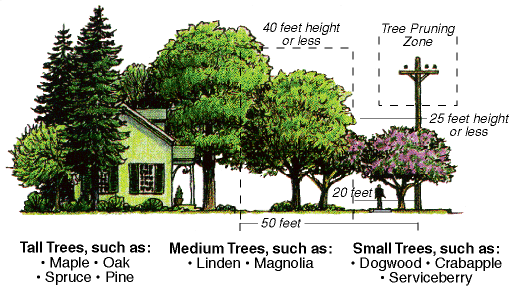Selecting the Right Tree and Vegetation for the Location
When planting trees around distribution overhead power lines typically found in residential areas, homeowners can help prevent service interruptions and minimize the need for pruning in the future - just by following a few simple guidelines.

This diagram is provided for informational purposes only and is not drawn to scale or intended for use as a specification detail.
The key is to select the right kind of tree for the location. If possible, avoid planting any tree directly underneath power lines. And, as the diagram shows, make sure any tree planted within 20 feet of neighborhood power lines is a variety that will grow to a mature height of 25 feet or less. Small trees such as flowering crabapple, dogwood or serviceberry are ideal for these locations. In addition, such trees often feature smaller root structures so they're also less likely to crack sidewalks and driveways or to clog underground drain lines.
Plant taller trees farther away to ensure they can't grow into power lines. At distances of 20 to 50 feet, plant trees that grow to a height of 40 feet or less. For instance, linden or magnolia trees are a good choice in these areas.
If you want to plant a tree that grows tall, such as a maple, oak, pine or spruce, make sure it's at least 50 feet from the nearest residential overhead lines.
Around long distance, high voltage transmission lines, more clearance is usually necessary. Before planting any tree near a transmission right-of-way, check the requirements of your property's easement.
Do not plant trees and shrubs too close to underground lines. Trees with shallow surface roots or deep spreading roots can damage them. Special care also should be taken when planting near above-ground pad mount transformers. Please plant trees and shrubs at least 10 feet away from a transformer’s service door, and at least three feet from its back and sides. Remember to consider the plants mature width prior to spotting the location
There are a number of tree varieties that are specifically not recommended for use near overhead lines of any kind. The disadvantages of these trees include brittleness - which makes them vulnerable to storm damage - or susceptibility to disease and insect infestations. Trees to avoid for these reasons include:
- Ash
- Black Locust
- Callery Pear
- Catalpa
- Box Elder
- Elm - American
- Elm - Siberian
- Horse chestnut
- Mulberry
- Poplar (Carolina, Lombardi or other hybrids)
- Silver Maple
- Sycamore
- Tree-of-Heaven
- White Pine
- Willow
Whether you're looking for more summer shade, an effective windbreak or just to enhance the beauty of your property, start by selecting the right tree for your location. Consult with your local nurseryperson or your county agricultural extension agent. If you have any questions, call our Contact Center and ask for our regional Forestry Services Staff.

